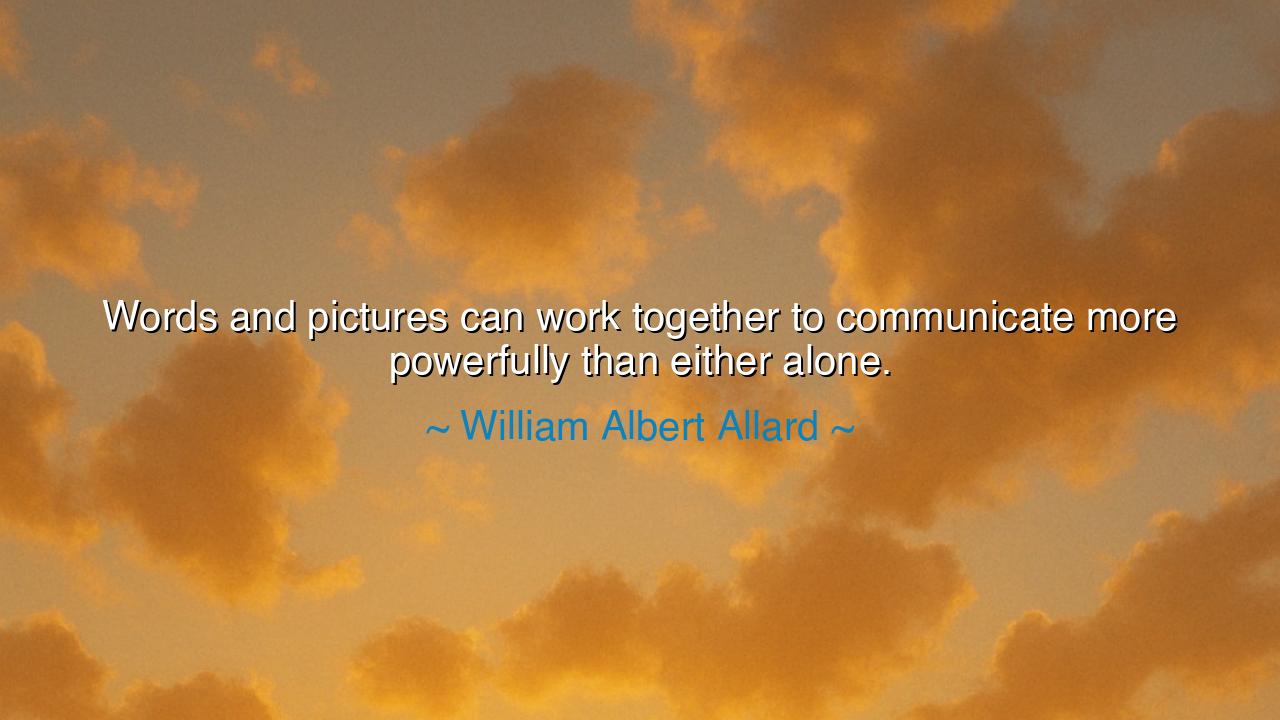
Words and pictures can work together to communicate more






In the luminous and perceptive words of William Albert Allard, a master of the lens and a poet of the human spirit, we encounter a truth both ancient and modern: “Words and pictures can work together to communicate more powerfully than either alone.” Within this revelation lies the understanding that language and image, though born of different elements, are twin vessels of meaning — one speaking to the mind, the other to the heart. When they join, they form a harmony of expression, a bridge between the seen and the unseen, the spoken and the felt. For a word can explain what an image cannot, and an image can reveal what words dare not name.
The origin of this insight rises from Allard’s long journey as a photojournalist for National Geographic, where he traveled through worlds both known and hidden — from the cobbled streets of Spain to the quiet deserts of the American West. In his craft, he learned that neither the pen nor the camera alone could fully capture the human story. A photograph might show a man’s sorrow in the curve of his back, but a few words could reveal the cause of that sorrow, the life behind the eyes. Allard understood that truth, like light, has many shades, and that only through the union of image and language can we begin to glimpse its fullness.
The ancients, too, knew of this sacred union. In the temples of Egypt, hieroglyphs danced with carvings of gods and kings — words and pictures intertwined, each giving life to the other. The walls did not speak through symbols alone; they sang through the marriage of art and meaning. The philosophers of Greece and Rome spoke of rhetoric and form, of how the painter’s vision and the poet’s voice together could stir the soul more deeply than either alone. Even in the scriptures of old, images were woven into the word — the burning bush, the parted sea, the dove descending — for the divine knows that the human heart learns not through intellect alone, but through the union of sight and spirit.
Consider the power of Dorothea Lange’s photograph Migrant Mother, taken during the Great Depression. The image alone — the weathered face of a mother, her children clinging to her shoulders — speaks volumes of hardship and endurance. But when joined with the story behind it — her hunger, her dignity, her faith that tomorrow might bring bread — the photograph becomes more than art. It becomes a cry across generations, a lesson in compassion and resilience. The words and the image together awaken something eternal in us: empathy. Without words, the image might be misread; without the image, the words might be forgotten. Together, they form a testament that endures.
Allard’s truth also carries a deeper teaching about collaboration — not just between mediums, but between souls. For just as words and pictures complement one another, so do reason and emotion, mind and heart, man and woman, thought and action. The wise understand that creation is strongest when forces unite. The artist, the teacher, the leader — all must learn to weave together the seen and the unseen, the rational and the feeling, if they are to move others. To choose only one is to speak half a language; to unite both is to speak the language of life itself.
But there is more — this union teaches humility. The word must learn to yield to the image’s silence, and the image must trust the word’s precision. Each must know its limits. In a time when many shout their truths in fragments — through pictures stripped of meaning or words stripped of soul — Allard’s wisdom reminds us that true communication is not noise, but harmony. It is not domination, but dialogue. To communicate powerfully, one must learn to blend clarity with feeling, light with language, intellect with imagination.
Therefore, my child, take this lesson into your own craft and your own life: let your words paint, and let your pictures speak. When you write, do not forget the image that breathes behind the sentence. When you create, do not neglect the story your creation longs to tell. Seek unity in your expression — and beyond that, in your relationships, your work, your being. For life itself is the meeting of opposites — of earth and sky, sound and silence, body and soul. The greater your harmony between them, the deeper your truth will resonate.
So let William Albert Allard’s words be your guide: “Words and pictures can work together to communicate more powerfully than either alone.” Remember that power lies not in force, but in balance — not in the loudness of one voice, but in the choir of many working as one. Whether through art, through love, or through the way you tell your own story, let your life be a composition of word and image, thought and feeling. For when all parts of your being speak together, the world will listen — not merely with its ears, but with its heart.






AAdministratorAdministrator
Welcome, honored guests. Please leave a comment, we will respond soon